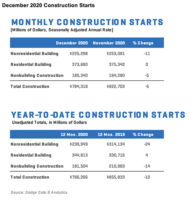U.S. construction starts will hold steady in 2019 after a modest 3% uptick in 2018, according to the 2019 Dodge Construction Outlook. Starts are expected to hit $808.3 billion, only 0.2% higher than 2018’s $806.8 billion.
“Over the past three years, the expansion for the U.S. construction industry has shown deceleration in its rate of growth, a pattern that typically takes place as an expansion matures,” says Robert A. Murray, chief economist at Dodge Data & Analytics.
For the non-residential sector side, the volume of commercial work is expected to drop 3%, with rising vacancy rates in the coming year slightly dampening construction, says Murray, who provided the 2019 market update in National Harbor, Md., on Oct. 25.
Retail construction continues to decline, largely due to the shift to online shopping, while hotel construction will slow following a 10% boost in 2018. Office and manufacturing buildings, however, will see small increases, at 1% and 2%, respectively. Institutional building, such as educational and healthcare structures, will rise 3%.
But Murray foresees a 3% hike in non-building construction starts, following a 3% drop in 2018. Public works will rise 4%, with increases projected in highway and bridge work as well as in environmental infrastructure.
Murray noted that the omnibus federal appropriations bill passed in March provided increased funding for transportation projects, while legislation such as America’s Water Infrastructure Act (WIFIA) that passed in October, will provide funds for environmental projects.
The economist predicts a decrease in electric utility work next year, but it is modest compared to last year’s 25% market falloff, which was largely due to a drop in new solar and wind projects.
Residential starts are set to drop 2%, bringing the total construction-start dollar value to $319.3 million. The decrease is largely due to multi-family housing, expected to fall 6% following a 5% increase in 2018. Single family housing is expected to hold steady, following several years of growth as the economy bounced back following the recession that began in 2008.
“There are, of course, mounting headwinds affecting construction, namely rising interest rates and higher material costs, but for now these have been balanced by the stronger growth for the U.S. economy, some easing of bank lending standards, still healthy market fundamentals for commercial real estate, and greater state financing for school construction and enhanced federal funding for public works,” said Murray.




